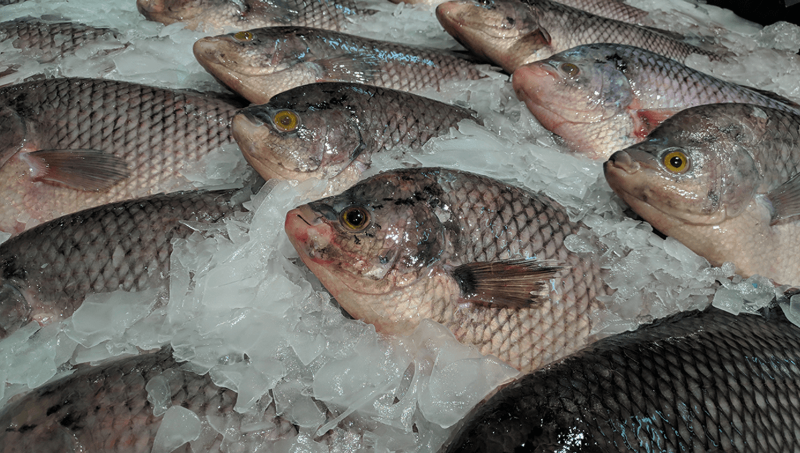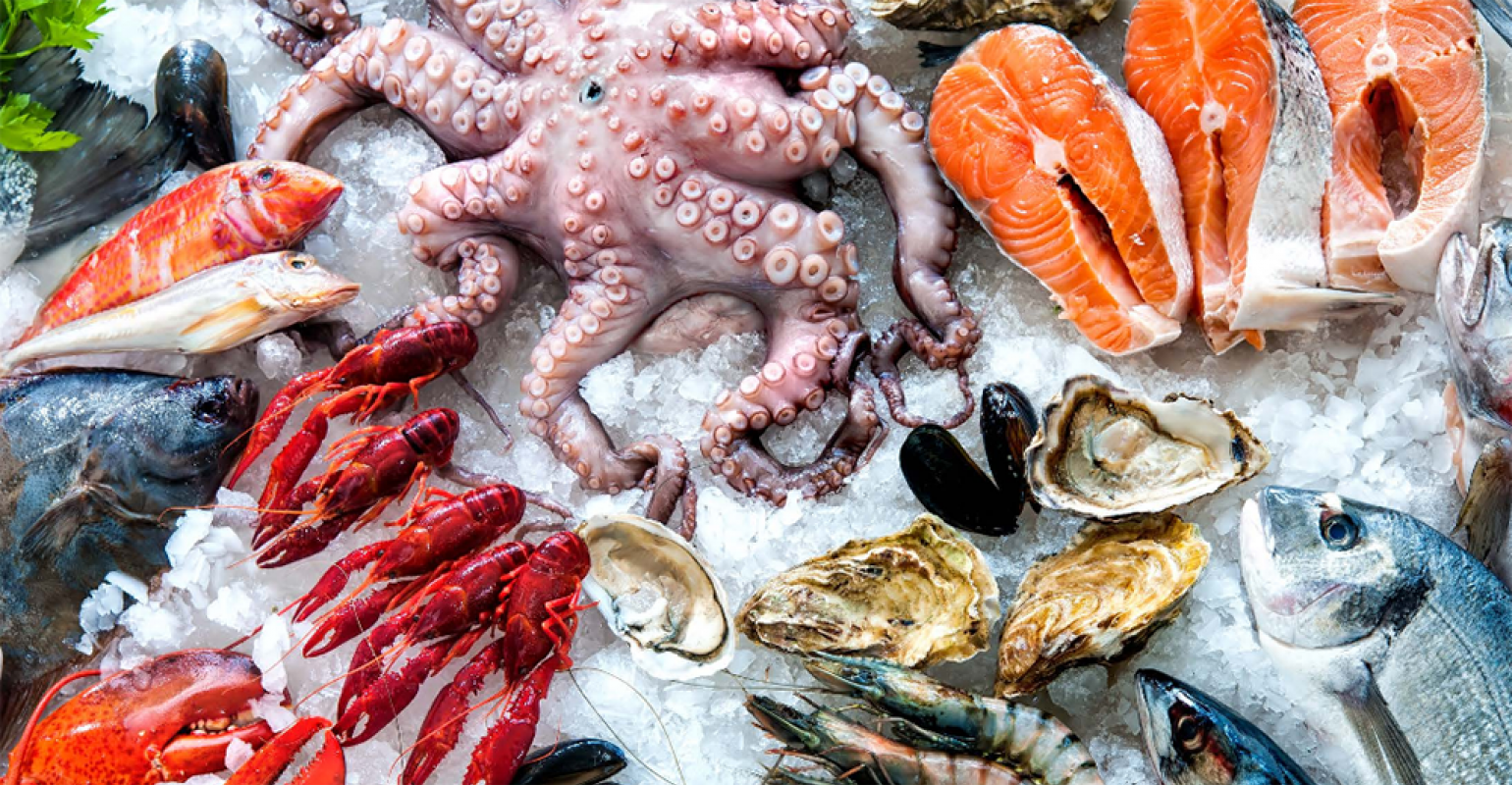Ozonated Ice & Fish Storage

Ozonated Ice & Fish Storage:
Ozonated ice, created by dissolving ozone gas into water and freezing it in an ice making machine, is a valuable tool in seafood storage. This process allows the ozone to be stored within the ice, resulting in what is commonly known as ozonated ice. By using ozonated ice in the storage of fish, the shelf-life of the product can be extended, leading to a fresher and more appealing end product for consumers.
The use of ozone to produce ozonated ice is not a recent development. In fact, as early as 1936, research conducted in the commercial fish industry in France demonstrated a remarkable 33% extension in the shelf-life of fresh fish stored on ozonated ice compared to ice produced from regular water in the fishing vessel's compartments.
Ozone can also be dissolved in water to wash seafood and fish fillets, effectively reducing bacteria and extending the shelf-life of fresh fish. Maintaining the highest quality of fish is crucial for the market value of fresh fish, as its appearance directly impacts pricing. The use of ozonated ice for storage on fishing vessels has been instrumental in preserving the premium quality of fish and commanding higher prices for fresh fish products. Given that fishing vessels can remain at sea for extended periods, it is essential to ensure that the fish and seafood harvested early in the voyage are as fresh and of comparable quality to those caught near the end of the voyage. Ozonated ice has proven to be a practical solution for addressing the unique storage challenges faced by the fishing industry.
The use of ozonated ice in fish storage has expanded beyond fishing vessels and is now employed in fish farming and processing operations throughout the industry. Many fish processors and fish farms rely on ozonated ice for their seafood storage requirements. The utilization of ozonated ice offers a convenient and effective method for prolonging the shelf-life of seafood products, ensuring that they remain fresh and of high quality for an extended period. This has significant benefits for both the industry and consumers, as it reduces waste and enables the delivery of superior seafood products to the market.
Dissolving ozone into water that is frozen as ice is essentially a method of storing ozone. Ozone will remain active, as ozone when stored as ice for months, and even years. Provided starting ozone levels, prior to freezing are high enough, that ice hold the ozone in a stored capacity for a prolonged period of time.
References:
- Use of ozone and ozonated ice increased shelf life of good quality sardines from 5 days to 8 days, and acceptable quality sardines from 15 days to 19 days - (effects of storage in ozonised slurry ice n the sensory and microbial quality of sardine)
- Salmon iced with ozonated ice extended shelf-life from 4 days to 6 days when compared to non-ozonated ice, this data led to full scale implemented of ozone at the same plant in full scale application shelf-life extension of 33-50% was realized (some ozone applications in seafood -2011 IOA)
- Catfish fillet's treated with aqueous ozone showed a shelf-life of 14 days, compared to 4-6 days for conventional treatments of iced fillets. In this case ozone provided greater than a 100% extension of shelf-life.
- Ozone applications for commercial catfish processing
- Squid stored on ozonated ice extended shelf-life by 12% and had a 2 log reduction in aerobic bacterial plate count vs squid stored on conventional flake ice with no ozone (some ozone applications in seafood -2011 IOA)
- Walter Blogoslawski stated in his paper “Some Ozone Applications in Seafood” that in his research plastic milk bottled filled with triple-distilled super-ozonized water (2-4 mg O3/ml water) frozen at -80-deg C could retain a residual of 1-2 mg of ozone for up to 6-months. (some ozone applications in seafood -2011 IOA)
- Sease (1976) has stated that the half-life of ozone at 0-deg C under sterile conditions is on the order of 2,000 years. Thus freezing water which contains residual ozone will produce ice containing ozone, which will reform water containing dissolved ozone when it melts. Ozone sterilized ice normally can be expected to be used within a few hours of it's manufacture, certainly within a few days. Under this scenerio, there should be little, if any, loss of ozone in the ice due to decomposition back to oxygen. (Review of the applications of ozone for increasing storage times of perishable foods – 1983 IOA)
Evaluation of an Ozone-Slurry Ice Combined Refrigeration System for the Storage of Farmed Turbit
Authors: Carmen A. Camposa, Vanesa Losadac, Óscar Rodrígueza, Santiago P. Aubourgc, Jorge Barros-Velázqueza
Abstract
The use of ozonised slurry ice was investigated as a new refrigeration system for the storage of farmed turbot (Psetta maxima). With this purpose in mind, an ozone generator device was coupled to a slurry ice system working subzero at −1.5 °C. The ozone concentration was adjusted to a redox potential of 700 mV, and the slurry ice biphasic mixture was prepared at a 40% ice/60% water ratio and 3.3% salinity. Certain biochemical parameters indicative of fish freshness, such as the rate of nucleotide degradation or TMA-N formation, were not significantly affected by the presence of ozone in the slurry ice mixture. However, storage in ozonised slurry ice significantly slowed down the mechanisms responsible for lipid hydrolysis and lipid oxidation in farmed turbot. Storage in ozonised slurry ice also led to significantly (p < 0.05) lower counts of both total aerobes and psychrotrophic bacteria in both turbot muscle and skin, as compared with the control batch stored without ozone. Sensory analyses confirmed an extended shelf life of turbot specimens stored in ozonised slurry ice; these maintaining “A” sensory quality up to day 14, while the counterpart batch stored in slurry ice kept this quality only up to day 7. The combination of ozone and slurry ice may be recommended for the chilling and storage of farmed turbot with a view to extending its shelf-life.
Effects of Ozonated water Treatment on Physico-Chemical, Microbiological and Sensory Characteristics Changes of Nile Tilapia Fillets During Strorage in Ice
Authors: Yongqiang Zhao
Abstract
Quality changes in commercial-sized Nile tilapia fillets sterilized by 4.0 mg/L ozonated water for 30-min and stored in ice for 18 days were evaluated. Malondialdehyde content increased from 1.54 ± 0.06 to 1.94 ± 0.14 nmol/mgprot after treatment at day 18, while drip loss rate, lightness, chroma, whiteness index and whilst hue values in the treated group were significantly higher (P < .05). These changes indicated that treatment had some adverse effects on fillet quality. Total volatile basic nitrogen (TVB-N) decreased from 27.67 ± 1.39 to 22.79 ± 2.77 mg/100g after 18 days storage. Hardness and chewiness increased from 73.78 ± 10.78 to 81.44 ± 16.54 g and 45.61 ± 14.81 to 49.85 ± 13.52 g mm respectively by the treatment at day 0. Besides, pH showed no significant differences between both groups throughout the storage period. Based on microbiological analysis and sensory evaluation, the shelf-life of treated and control fillets was 14 and 11 days, respectively. The results of this study indicate that ozonated water treatment is effective in enhancing textural properties, reducing total viable counts and extending shelf-life during ice storage.
Some Ozone Applications in Seafood
Author: RIP G. RICE
Abstract
Ozone, the second most powerful oxidant readily available, is an excellent sterizing agent as well as chemical oxidizing agent. Because of this property, it has been studied for preservation of foods. Indeed, many European countries currently employ ozone for maintaining holds of refrigerated ships free of bacteria, molds, odors, etc., for preservation of cheese, eggs, some meats, poultry, some berries and some fruits. Much of this technology was developed shortly after World War II. Many of the earlier studies reported in the literature come to conflicting conclusions with respect to the efficacy of ozone in providing improvements in storage lives of perishable foods.
In light of modern advances in ozone generation and associated equipment, as well as increased understandings of the various technologies associated with the application and handling of ozone, and advances in methods of food transportation (containerized and modulation), it is believed to be timely to re-evaluate the potentials for this versatile, but little understood oxidant/disinfectant. This paper represents a first attempt to review past and current studies, with suggestions for future studies to develop those benefits which appear to be achievable for the food preservation and distribution industries.
The use of ozonized seawater to reduce and eliminate bacterial pathogens in mariculture facilities and to extend shelf life of marine food products is demonstrated. Consequent benefits of this treatment are also discussed. Laboratory and pilot experiments were conducted using ozone gas to reduce disease-producing Vibrio sp. bacteria at a shrimp (Litopenaeus vannameii) hatchery in Ecuador, South America. Pacific Ocean seawater was treated in a 1,540 L capacity fiberglass contact tower (5–7 min retention) with an ozone oxidant residual of 0.07 mg/L. Prior to ozone treatment, Vibrio determined by TCBS plating was too numerous to count, causing shrimp to die of disease (30 tanks of 13,000 L each). After treatment, Vibrio counts and shrimp disease were eliminated, ozonized seawater decreased the time required for normal molting of shrimp and the total growth cycle was reduced by three days versus control water. From June 1991 until September 1992, survival rates of larval shrimp were robust, routine antibiotic addition was reduced, and one additional growth cycle was realized. Ozonized ice (fresh water) was prepared in the Milford Laboratory CT, USA; Gloucester Food Tech Lab, MA, USA; and a field station (brine water) for sockeye salmon (Oncorhynchus nerka) in Homer, AK. USA. In these studies, squid (Loligo pealei) and commercially captured salmon demonstrated a reduction in spoilage and extension of shelf life of 3 to 5 days' time using ozonized ice. Bacteria associated with commercial ice-producing machines were reduced by 4 logs using ozone treatment. In addition, no flavor aberration was noted using ozonized ice.
Author: Charles Odilichujaw R. Okpala
Abstract
Ozone treatment, declared ‘Generally Recognised As Safe’ three-decades-ago and shown to reduce microbial numbers and extend shelf life of seafood products, is still under investigation. Health regulatory standards have stipulated to makers of ozone generating facilities to establish optimum quantities of zone discharge that would produce significant effects. To our knowledge, no investigation regarding the quality characteristics of shrimp subject to minimal ozone treatment shortly after harvest and stored on ice has been carried out so far. For that reason, the present study evaluates some quality characteristics and the shelf life of Pacific white shrimp (L. vannamei) subject to minimal ozone treatment (ozone discharge: 100 mg/h; wash time: 1 min) shortly after harvest and then stored on ice. The quality indices were examined in terms of microbiological and chemical characteristics to estimate the shelf life. By average, the shelf life of minimal ozone-treated shrimp was estimated to extend by ~1.75 days based on acceptable limits cumulative of total viable count (TVC), trimethylamine-nitrogen (TMA-N), total volatile basic-nitrogen (TVB-N) and peroxide value (PV). There were obvious differences in acidity, total colour difference (TCD), correlations and temporal rates of TMA-N and TVB-N as well as PV and p-anisidine (AnV) between minimal ozone-treated and untreated shrimp (P < 0.05). Acting like an antioxidant minimal ozone treatment could reduce the TMAN, TVB-N, PV and AnV of Pacific white shrimp. The results provided by this study indicated that the minimal ozone treatment combined with iced storage could influence some quality parameters and extend the shelf life of Pacific white shrimp.
Link to full paper can be found HERE
Combining Ozone and Slurry Ice Treatment to Prolong the Shelf-Life and Quality of Large Yellow Croaker
Author: Yanan Zhao
Abstract
The effect of different ice treatments (flake ice (FI), slurry ice (SI) and ozonated slurry ice (OSI)) on the microorganism, physicochemical properties and shelf life of large yellow croaker (Pseudosciaena crocea) was evaluated during refrigerated storage. Microbiological and physicochemical analysis, low-field nuclear magnetic resonance (LF-NMR) and magnetic resonance imaging (MRI) were measured at 3-days interval. The results showed that, compared with FI, SI could greatly inhibit the growth of microorganisms and slow down the increase of TBARS, TVB-N, K value and BAs, which had the ability to isolate oxygen and cover the fish completely with subzero temperature. While OSI could inhibit the increase of microbial number, K value and BAs dramatically, which were closely related to strong bacteriostatic ability of ozone. The results of LF-NMR and MRI revealed that the combined use of slurry ice and ozone could more efficiently retard the water migration, maintain the quality of fish. This experiment revealed that combined use of slurry ice and ozone represented a promising technique to maintain high safety and quality and extend the shelf-life of large yellow croaker.














